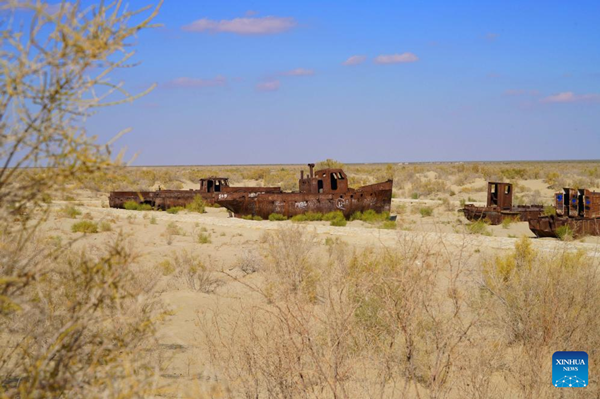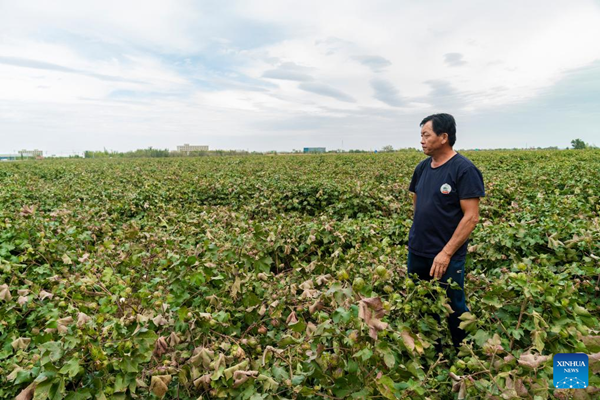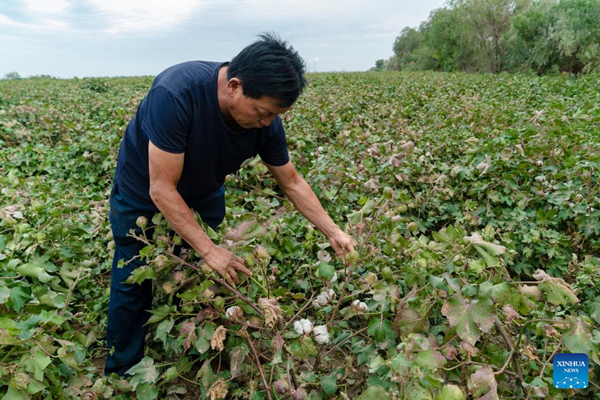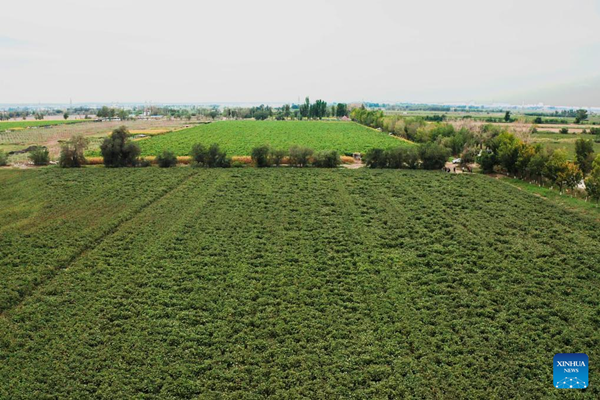【Xinhua】Feature: Conserving the Aral Sea -- sustainable tech improves harvest, ecosystem in Central Asia
2023-09-25

Abandoned ships run aground in the Aral Sea, once the world's fourth-largest lake, in Uzbekistan, Sept. 29, 2021. (Photo by Zafar Khalilov/Xinhua)
TASHKENT/URUMQI, Sept. 22 (Xinhua) -- Uzbek farmer Sherzod Donaev is counting the days until reaping a bumper harvest of some 5,000 kg per hectare from his cotton fields.
Three years ago, Donaev could not imagine such a good yield. By adopting a water-saving irrigation system, the annual yield nearly doubled, and inputs of labor, fertilizers, and water have all decreased significantly, he told Xinhua.
In 2020, Donaev became the first in his village to use the water-saving cotton cultivation technology under the guidance of experts from the Xinjiang Institute of Ecology and Geography (XIEG), Chinese Academy of Sciences.
For him, the technology not only increased his family income but also offered him an exciting prospect for a more beautiful homeland.
While Uzbekistan is famous for its cotton production, in the past several decades the livelihoods of Uzbek cotton farmers have been under severe threat from the ecological crisis of the Aral Sea.
Once the world's fourth-largest lake, the Aral Sea has shrunk remarkably since 1960 -- with its surface area dwindling from 67,000 square km in 1960 to just 6,000 in 2020.
The exposed lake bed has been a main source of salt as well as dust storms, said Chen Xi, director of the Research Center for Ecology and Environment of Central Asia, Chinese Academy of Sciences.
After nearly five years of cooperation, Chinese and Uzbek scientists found out that increased evaporation caused by rising temperatures is a key factor in the Aral Sea crisis. They then proposed the adoption of a water-saving technology as a solution to restore the lake.
Chen said that saving water is a crucial step toward ecological sustainability for Uzbekistan, Kazakhstan, and the surrounding area, such as China and Eastern Europe. "We are interconnected with each other and share the only Tianshan Mountains," he said.
"We calculated that widespread adoption of the technology in Uzbekistan's main cotton-producing regions is expected to save 8-10 billion cubic meters of water annually, effectively maintaining the Aral Sea's surface area and reducing salt and dust storms," he said.
In northwest China's Xinjiang Uygur Autonomous Region, the expertise in water-saving technology, such as mulching drip irrigation, has been well established in agricultural activities for many years.
In a cotton field near Urumqi, cotton farmer Gong Lunquan showed an irrigation station to Xinhua. He explained that drip irrigation saves at least 500 cubic meters of water per mu (667 square meters) annually, and yet brings about a significant increase in yield.
The basin irrigation used in the past could result in uneven watering, where you saw floods in low places and drought in high ones, but the drip irrigation has perfectly solved that problem, Gong said.
Over the years, research institutes in China and Uzbekistan have set up several demonstration zones for water-saving fields, and Donaev's cotton fields are among these zones.
Shamshodbek Akmalov, associate professor at the Tashkent Institute of Irrigation and Agricultural Mechanization Engineers, National Research University, has long collaborated with Chinese scientists in seeking solutions to the Aral Sea crisis.
"The Aral Sea is starting to be a global problem. I am sure, and I saw many times when visiting China, that there are sciences with high potential," he said in a recent interview, adding that the path to solutions lies in technological cooperation.
Liu Tie, a researcher at the XIEG, told Xinhua that the technology applied in Uzbekistan is not merely a duplicate of Chinese practices but also a solution tailored to local needs, crafted through a series of experiments and adaptations.
Liu has devoted years to the ecological research in Central Asia and has witnessed growing acceptance of and trust in scientific cooperation among local people.
"For our shared homeland, any amount of effort is worth it," he said.

Cotton farmer Gong Lunquan checks the growth of cotton in a cotton field near Urumqi, northwest China's Xinjiang Uygur Autonomous Region, Sept. 14, 2023. (Xinhua/Zhou Shengbin)

Cotton farmer Gong Lunquan checks the growth of cotton in a cotton field near Urumqi, northwest China's Xinjiang Uygur Autonomous Region, Sept. 14, 2023. (Xinhua/Zhou Shengbin)

This aerial photo taken on Sept. 14, 2023 shows cotton fields near Urumqi, northwest China's Xinjiang Uygur Autonomous Region. (Xinhua/Zhou Shengbin)
Contact:
LIU Jie
Xinjiang Institute of Ecology and Geography, Chinese Academy of Sciences
Phone: 0991-7885505
E-mail: liujie@ms.xjb.ac.cn
Web: http://english.egi.cas.cn/



